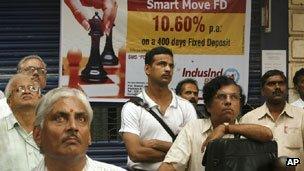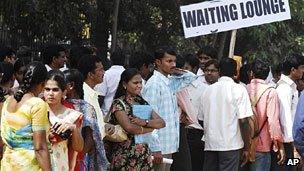A rosy future for India's economy?
- Published
- comments

India's growth slowdown has been mild
Two years ago, as I moved from the US to become adviser to the Indian government, in Delhi's imposing North Block, I decided to call it a day as a BBC columnist.
Yet these have been wondrous years, with much to record.
An early cue that I was in a new setting came in the very first week, as I reached for the seat belt in my office car.
My kindly government driver, knowing that I had come into "high office" from academe, turned to me: "Sir, now that you are chief economic adviser, you don't need to wear a seat belt."
'Witch-hunt'
It became soon evident that, as far as policy-making goes, India is no different from any industrialised nation.
Globalisation and India's open society has ensured that much of the same discussion that occurs in Europe and North America occurs in the North Block.
As I write this comment, the Indian economy is going through a difficult patch. Industrial growth has slowed over the past half-year and inflation has remained high.
Some of the factors behind this are known.
Starting with the Commonwealth Games and the 2G spectrum sales, corruption charges have vitiated India's business ethos.
There is a build-up of civil society anger about the ubiquity of corruption. While this is welcome, this has encouraged a witch-hunt, suggestive of Arthur Miller's The Crucible, in which everybody treats everybody as suspect.
The consequence is that bureaucrats are hesitant to take decisions, since doing nothing is one way to ensure that you do nothing wrong.
What is needed is to go after corruption but to do so with an intelligently-designed enforcement system, using contemporary ideas from law and economics.
We must not return to the "raid Raj" days, when the government, in search of hoarders, unleashed a hostile bureaucracy, bringing even legitimate trading and stocking activities to a halt.
Second, the eurozone crisis and the global slowdown are creating headwinds for India.

"There is a build-up of civil society anger about the ubiquity of corruption"
The general slowdown among G20 nations is sharp. Only one country, Australia, grew faster in the second quarter (1.4%) than in the first quarter (1%).
However, despite these woes, once we turn our attention to the fundamentals, there is reason to be optimistic about India.
Even after the slowdown, India is growing at more than 7.5%.
Further, what often goes unremarked is that, since 2003, India has been saving and investing well over 30% of its national income.
This is reminiscent of the East Asian economies during the heydays of growth.
As India reaps a "demographic dividend" - which refers to a rising bulge in the working-age group population that will occur over the next 20 years - it is expected that the savings will rise further.
None of these changes have been brought about by an authoritarian government.
Central banking
After Independence, there were periods when India thwarted the inflow of goods and services, but, luckily, never ideas.
This openness has nurtured democracy and widespread participation, and given India a stability which many emerging economies do not enjoy.

Savings will rise as India reaps a demographic dividend
As a consequence of these emergent strengths and India's arrival on the global scene, the nation can no longer look away from the challenges of money and finance that the world faces and which have a direct bearing on India.
I pick one example each from money and finance.
It was realised at least three centuries ago that a single economy should have at most one central bank.
The Riksbanken in Sweden, in 1664, and the Bank of England, in 1694, were founded with this in mind. Soon this became the norm and gradually virtually every nation had its own central bank.
This model served the world well for long, but with globalisation - money and goods flowing easily across nations - the world is beginning to look like a single economy.
Since the world has many central banks, this means that we are inadvertently going back to the arrangement we tried to shed in the 17th century.
This has weakened the power of monetary policy for each nation and has given rise to large spillover effects.
The UK has injected £75bn ($120bn) into its economy. But this does not seem to have had the impact it would once have had in boosting its growth.
On the other hand, it exerts an upward pressure on prices in India, China and Brazil.
Evidently, central banking needs co-ordination of a kind that the world does not have today.
Too Rich to be Poor
Turning to finance, a central problem is the mantra, Too Big To Fail, repeated often enough to have acquired the clumsy acronym TBTF.
The argument is simple.

There have been global protests over austerity and banking practices
Some banks are so large that their collapse would inflict huge collateral damage on ordinary consumers and workers. So, to protect the latter, we need to recognise that some banks are TB to be allowed TF.
The recognition of this problem gave rise to major rethinking on finance and new legislation for financial markets.
However, there is one mistake we made.
TBTF has been misread as TRTP - Too Rich to be Poor - meaning state insurance is provided not just to the big banks but their rich owners and chiefs.
What is needed is a policy that ensures that, when a big bank fails, we have enough capital to prevent the bank's collapse, but we permit the owners and chiefs, who were behind the decisions that led to the failure, to fail.
Not to do so is not just morally wrong, it encourages bad decisions and excessive risk-taking.
What the world does in terms of central banking and the rules of finance is critically important to India. That was always the case.
What is different is that India is, for the first time, in a position to influence these debates and help shape the rules of the game. It must take up the challenge and be a worthy participant at the global roundtable.
Kaushik Basu is Chief Economic Adviser to the Government of India, Ministry of Finance, and C Marks Professor and Professor of Economics, Cornell University. His most recent book, Beyond the Invisible Hand: Groundwork for a New Economics, was published earlier this year.
- Published14 November 2011
- Published19 October 2011
- Published26 September 2011